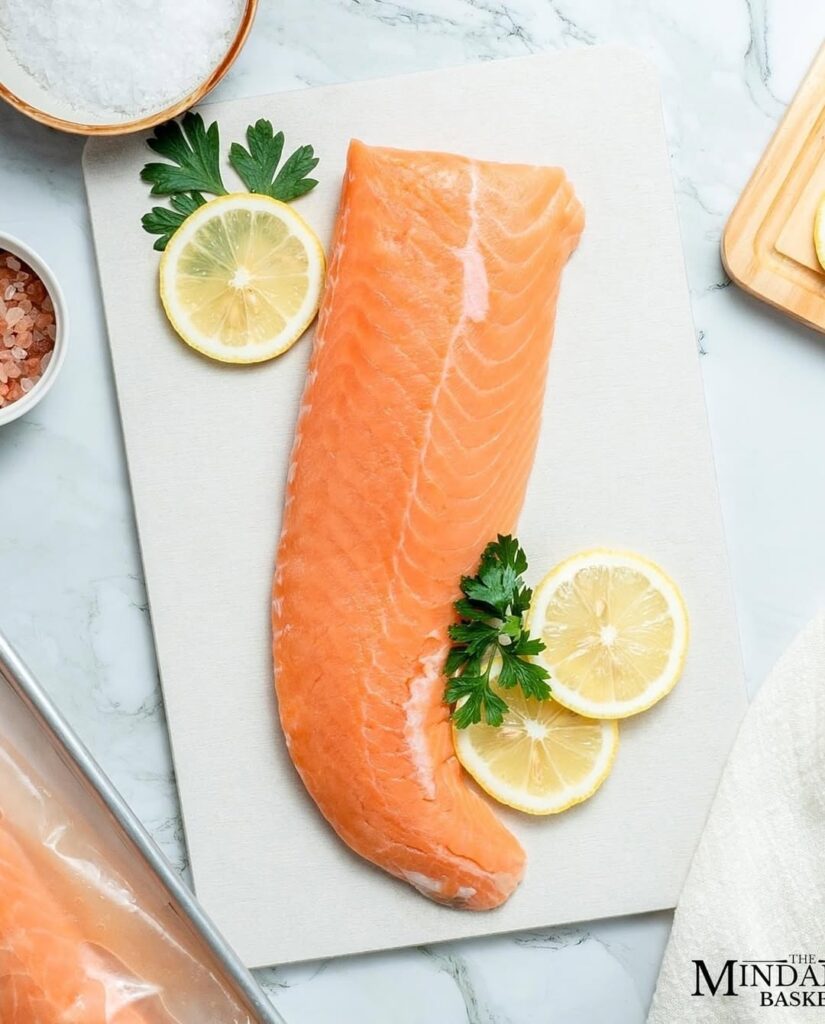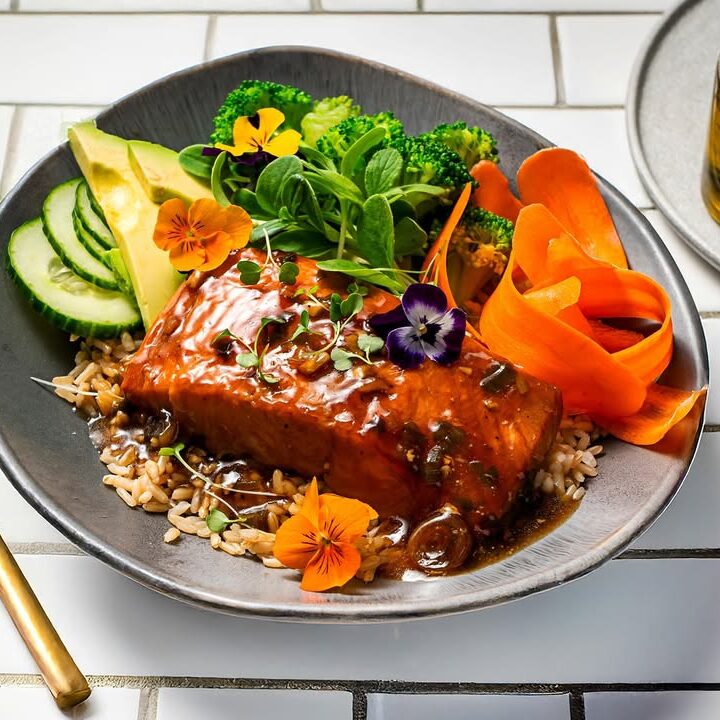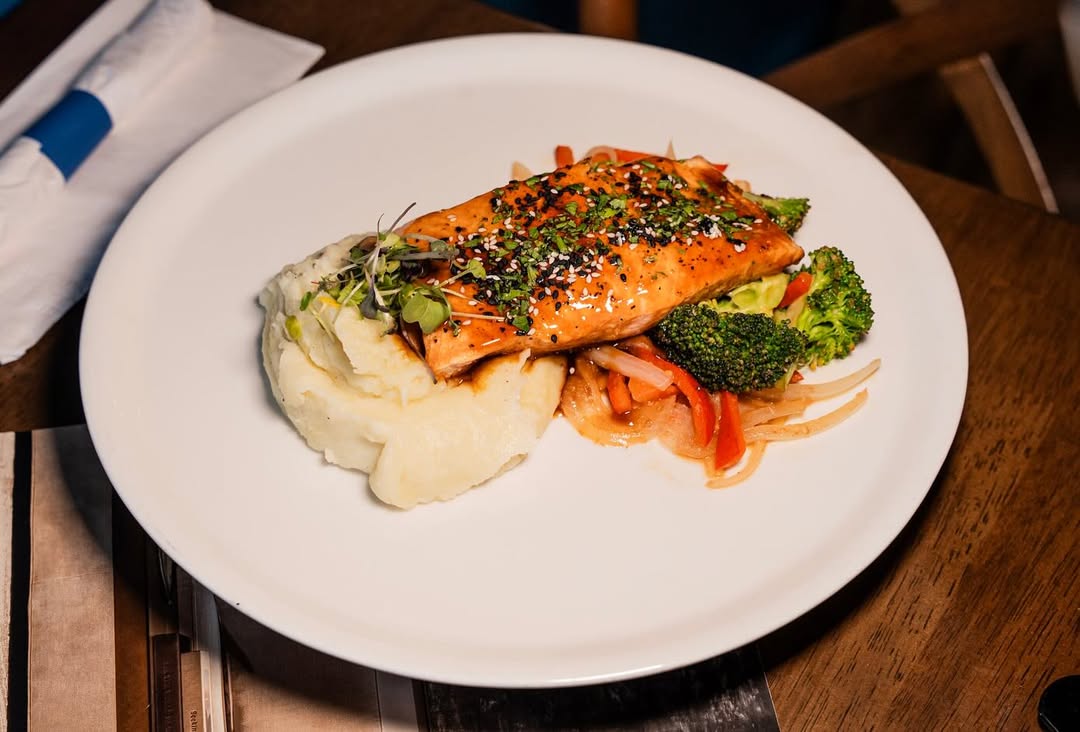Honestly speaking, salmon is a whole different kind of beast to tame on the grill. Dare I say that grilling salmon can feel like a high-stakes game.
You either nail it with that golden, crisp skin and buttery inside – or end up with a flaky disaster that welds itself to your grill.
I’ve been there. Early in my career, I once lost half a salmon to a grill grate – it looked like modern art but didn’t taste like it.
Here’s the good news: perfectly grilled salmon isn’t about luck. It’s about knowing what’s actually happening when fish hits fire. With a few simple techniques, you’ll go from “please don’t stick” panic to confident grill master status.
Why This Recipe Works
Salmon is naturally fatty, which is great – it’s basically built for the grill. That fat keeps the fish moist, but only if you handle it right. Too much heat too fast, and it’ll tighten up like a bad handshake.
Too little, and the skin steams instead of crisps. The secret? High heat, minimal flipping, and skin-on fillets.
The skin acts as armor, protecting the delicate flesh and crisping beautifully when it’s given the chance to sit undisturbed.
Think of your grill like a cast iron pan turned up to 11. Once it’s hot enough and oiled properly, it’ll sear the skin instead of tearing it. That’s the foundation of perfectly grilled salmon – crispy outside, tender inside, every single time.

Choosing the Right Cut of Salmon
Not all salmon fillets are created equal. If you want perfectly grilled salmon, start with the right cut. Go for center-cut fillets – thick, even pieces that cook uniformly. Tail pieces tend to be thinner and can overcook faster than you can say “medium-rare.”
Skin-on fillets are your best friend; the skin holds everything together and develops that irresistible crisp texture when treated right. When shopping, look for vibrant color (bright orange to deep red, depending on the species) and moist, firm flesh.
Dull or slimy? Hard pass. If you’re lucky enough to find wild-caught varieties like sockeye or king salmon, grab them – their flavor and fat balance make them ideal for grilling. And remember: fresh doesn’t always mean best.
High-quality frozen salmon, thawed properly, often beats “fresh” fish that’s been sitting on ice for days.
Marinades vs. Dry Seasoning
There’s a great debate among grillers: marinade or dry rub? Truth is, both can work – it just depends on what you want. Marinades infuse flavor and keep the fish juicy, but they can also cause flare-ups if sugary or oily.
If you go this route, keep the marination short (20–30 minutes tops) and pat the fish lightly before grilling to avoid dripping excess liquid on the flames. Dry seasonings, on the other hand, let the salmon’s natural taste shine.
A mix of salt, pepper, garlic powder, and lemon zest builds a clean, crisp crust that doesn’t fight with the grill. For beginners, dry seasoning is foolproof and easier to control.
For flavor adventurers, experiment – a soy-honey glaze brushed on during the last minute adds shine and complexity without burning. Either way, balance is the name of the game.

The Best Oils and Fats for Grilling Salmon
When it comes to perfectly grilled salmon, the oil you use matters more than most people realize. You need something with a high smoke point – meaning it can take serious heat without burning or turning bitter.
Skip butter or extra virgin olive oil for direct grilling; they smoke too early and leave a harsh flavor. Instead, reach for avocado oil, refined olive oil, or grapeseed oil. These stay stable up to 450°F and help form that signature golden crust.
Lightly brushing the salmon and the grill grates before cooking creates a slick barrier that prevents sticking.
Bonus tip: after grilling, then you can finish with butter or olive oil for richness and aroma.
Think of it as a two-step flavor strategy – neutral oil for cooking, flavorful fat for finishing. Your taste buds (and your smoke alarm) will thank you.
Tips for Success
These small moves make a huge difference:
- Dry your salmon completely before grilling. Water turns to steam, which ruins crisp skin.
- Oil both the fish and the grill grates. Insurance against sticking.
- Don’t flip too early. Wait until the skin releases naturally – it’s telling you it’s ready.
- Avoid overcooking. Salmon keeps cooking after you take it off the grill. Pull it a few degrees early.
- Charcoal vs gas: Charcoal gives more flavor, but gas gives more control. Choose your adventure.
Troubleshooting
- Fish stuck? Grill wasn’t hot enough or clean enough.
- Dry salmon? You went too long. Remember: tender salmon comes from confidence, not caution tape timing.
Flavor Variations
Once you’ve mastered the technique, you can dress it up however you like.
- Asian-Style Glaze: Mix soy sauce, honey, and grated ginger. Brush it on during the last minute of grilling.
- Mediterranean Twist: Rub with olive oil, garlic, oregano, and lemon zest.
- Spicy Cajun: Combine smoked paprika, cayenne, and thyme for a kick that pairs beautifully with grilled corn or dirty rice.
Each version keeps the same crispy-outside, tender-inside magic while giving you a new flavor profile to play with.
Serving Suggestions
Grilled salmon loves simple company. Try it with roasted vegetables, a bright citrus salad, or even a chilled quinoa bowl.
Feeling fancy? Serve it over garlic mashed potatoes with a drizzle of herb butter.
And if there’s any leftover (unlikely, but let’s pretend), it’s fantastic cold the next day over greens or stirred into pasta.
Pairing Salmon with Wine and Sides
A great meal isn’t just about the main event – it’s about harmony. The beauty of grilled salmon is how flexible it is with sides and drinks.
If you’re keeping things fresh and citrusy, a crisp white wine like Sauvignon Blanc or Pinot Grigio balances the fat beautifully.
Want something richer? A light Pinot Noir works surprisingly well with salmon’s smoky, grilled flavor. On the plate, go for contrasts: creamy mashed potatoes against crunchy asparagus, or a cool cucumber salad beside the warm fish.
If you’re grilling outdoors, think seasonal and simple – grilled corn, herbed rice, or even pineapple skewers for a tropical touch. The key is balance: let the salmon shine as the hero, and let everything else play backup vocals.

How to Store and Reheat Grilled Salmon
So you managed to show restraint and didn’t inhale all the salmon in one sitting – impressive. Here’s how to keep your leftovers just as good tomorrow. Store your grilled salmon in an airtight container in the fridge for up to three days.
When reheating, the goal is to warm it gently without drying it out. Skip the microwave (it’ll turn your masterpiece into rubber). Instead, use an oven set to 275°F for 10–12 minutes, or warm it in a covered skillet over low heat with a splash of olive oil.
You can also repurpose cold grilled salmon in salads, wraps, or rice bowls – it tastes incredible chilled with a squeeze of lemon. Whatever you do, never waste it. Good salmon deserves a second act, not a trip to the trash.
Nutrition Snapshot
Per serving: about 320 calories, 22g protein, 2g carbs, and 24g healthy fats.
It’s loaded with Omega-3s and Vitamin D – so yes, this is one of those rare meals that’s as good for you as it tastes.
The Takeaway
Perfectly grilled salmon isn’t just about technique – it’s about confidence. Once you understand the why behind the steps, the process becomes second nature. You’ll know the sizzle sound that means the skin is crisping right, and the look of salmon that’s cooked just enough.
Next time someone says grilled salmon is tricky, smile, hand them a fork, and let your fish do the talking.
And if a little piece still sticks to the grill? No worries. Call it the chef’s tax. You’ve earned it.

Perfectly Grilled Salmon with Crispy Skin and Zesty Lemon Finish
Image credit: @cuisinesolutions
Ingredients
- 4 salmon fillets (about 6 oz each, skin-on preferred)
- 1 tablespoon olive oil – helps the skin crisp and prevents sticking
- 1 teaspoon sea salt
- ½ teaspoon black pepper
- 1 tablespoon lemon juice – brightens the flavor
- 1 teaspoon garlic powder (optional, but adds nice depth)
- Fresh dill or parsley – to garnish like a pro
Pro tip:
- Choose wild-caught salmon if you can. It’s firmer, less oily, and tastes cleaner than farmed fish.
Tools You’ll Need
- Grill (gas or charcoal, both work)
- Fish spatula or long tongs
- Paper towels (for drying the fillets)
- Brush or folded paper towel for oiling the grill
Instructions
- Prep the Salmon. Pat the fillets bone-dry with paper towels. Moisture is the enemy of crispiness – it turns your grill into a sauna instead of a sear zone. Rub both sides with olive oil, then season generously with salt, pepper, and (if you like) garlic powder. Let the fish rest for 10 minutes at room temperature. This prevents that “shock” moment when cold fish hits hot metal and tightens up.
- Preheat the Grill. Heat your grill to medium-high (about 400–450°F). Clean the grates like your dinner depends on it—because it does. Any leftover bits will snag your salmon’s skin. Brush or wipe the grates with a thin layer of oil. You’re creating a nonstick surface without the chemicals.
- Grill Skin-Side Down. This is where most people panic and start moving the fish around. Don’t. Lay the fillets skin-side down and leave them alone for 5 to 6 minutes. The skin will crisp and naturally release when it’s ready. Resist the urge to “check.” This is a relationship built on trust. While the salmon cooks, you’ll see the color slowly change from deep orange to light pink as the heat rises through the flesh. That’s your visual timer.
- Flip Carefully. When the skin lifts cleanly, use a thin spatula to gently flip each fillet. Grill the other side for 2 to 3 minutes, just until the flesh is opaque and flakes easily. If you’re measuring temperature, aim for 125°F for medium or 130°F for well-done. Pull them off the grill and let them rest for 2–3 minutes. Like steak, salmon needs that short break to let the juices redistribute.
- Finish with Freshness. Right before serving, hit it with a squeeze of lemon juice and a sprinkle of herbs. The acid from the lemon brightens everything and cuts through the natural richness of the salmon. If you’re feeling indulgent, a swipe of melted butter or honey glaze while it’s still warm will make your guests think you’re running a restaurant.
Featured image credit: @eltanquetrattoriabar

